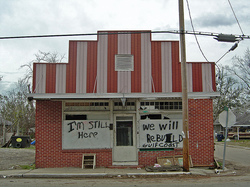Lessons from the Gulf: How can we better prepare for disasters?
 "Strictly speaking, there are no such things as natural disasters." So reads the U.N.'s International Strategy for Disaster Reduction, which lays out how countries can better prepare for things like hurricanes, tsunamis or other catastrophes. As the U.N. points out, there are only "natural hazards" -- which become "disasters" depending on human-made policies that make people more or less vulnerable to harm.
"Strictly speaking, there are no such things as natural disasters." So reads the U.N.'s International Strategy for Disaster Reduction, which lays out how countries can better prepare for things like hurricanes, tsunamis or other catastrophes. As the U.N. points out, there are only "natural hazards" -- which become "disasters" depending on human-made policies that make people more or less vulnerable to harm.People in the Gulf Coast have a deep appreciation of this interplay between "natural" and "unnatural" disasters. Over the last five years, the Gulf has been hammered by Hurricanes Katrina, Rita, Gustav and Ike, and the BP oil catastrophe.
The media likes to call Gulf residents "resilient" for enduring this stream of assaults. But what exactly makes a community resilient -- and what can our country do to make sure its people are less vulnerable and better able to recover from disaster?
Such issues are the focus of a growing body of research on disaster resilience, which argues that while technical issues like evacuation routes and other staples of disaster planning are critical, the best -- and in the long-run, cheapest -- way to prepare for disasters is to tackle long-standing social problems like poverty, racial disparities and other social ills.
In a 2008 report, Oxfam -- which has run relief and recovery projects in the wake of disasters around the globe -- looked at the factors that made communities more vulnerable to disasters. Their finding:
The extent of damage wreaked by natural events is not solely down to nature. Poverty, exclusion, inequality, as well as inappropriate political decisions and actions all play their part. In other words, social conditions shaped by humans increase people's vulnerability to disasters and make recovery more difficult.This was often the case with Hurricane Katrina. To cite just one example from the Institute for Southern Studies' report on human rights and Katrina, the evacuation plan Louisiana and the federal government had in place before the storms relied on personal vehicles as the primary means of escape -- despite the fact that about one-third of New Orleans residents, or about 120,000 people, didn't own cars.
On the flip side, Oxfam also argues that the way to make people less vulnerable and more resilient is to address poverty and inequality -- in other words, to focus on the slower-moving but no less devastating social disasters that have plowed through the Gulf Coast for decades, and have been intensified by the Great Recession.
This will be important to remember as we size up the progress of recovery of New Orleans and the Gulf Coast on the five-year anniversary of Katrina this month. In their excellent report The New Orleans Index at Five, the Brookings Institution and Greater New Orleans Community Data Center make a convincing case for optimism about many aspects of the city's renewal: The population is up to about 90 percent of pre-Katrina population, wages are up, poverty is down, neighborhoods are reviving.
In their study, Brookings and the Data Center also lay out their own list of factors that have helped New Orleans grow more resilient in the face of disaster. These include a strong and diverse regional economy, large shares of skilled and educated workers, wealth, strong social capital, and "community competence."
They conclude New Orleans is improving on many of those fronts, but the study also reveals that lingering problems -- especially poverty and inequality -- continue to make it a fragile recovery. For example, median household incomes in New Orleans for African-American and Latinos are 44 percent and 25 percent lower [pdf] than those for whites, respectively.
These lingering disparities will continue to make the poor and people of color less resilient and more vulnerable to the devastation of future disasters. Oxfam also concludes that lowered resilience can become a vicious spiral, where increased vulnerability to disasters inflicts more damage on the economy and social structure, further lowering resilience and heightening vulnerability.
So how can we prepare for disasters? Better disaster policies and systems are a start, but the most important -- and most cost-effective -- approach is to confront social problems we should be facing anyway.
Tags
Chris Kromm
Chris Kromm is executive director of the Institute for Southern Studies and publisher of the Institute's online magazine, Facing South.
